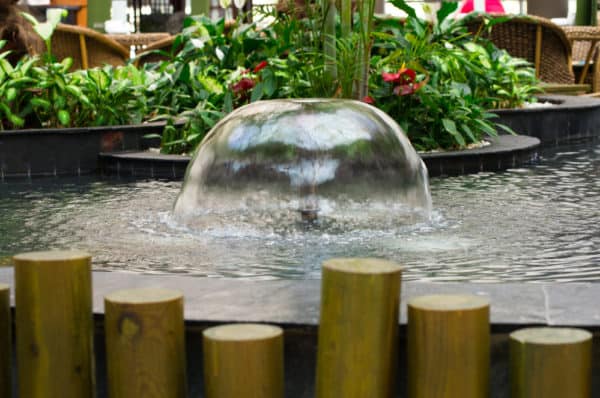Do you really need a pond filter or is a pump enough? Here’s what you need to know.
You do not need a pond filter to keep your water clean if you spend time balancing pond vegetation. Floating plants block the sun from the water making it harder for algae to grow. However, a filter is the easiest and most effective way to ensure that your pond does not become murky.
Some say filter, some say plants, and both are effective. However, using a pond filter should be considered before you decide to go the natural route.
Keep it Clean
Some water features do not need filters at all. Many garden fountains will be fine without one since most of them do not house wildlife. Fishless ponds can also survive without a filter since they will not have all the waste and bacteria fish bring. However, if your goal is pristine water and a pristine water feature, you may want to give filters a try.
Any water feature including pet fountains, garden and interior fountains, or ponds are going to get dirty at one time or another. Bacteria and grime will build up and get trapped inside the feature. Your feature will never be clean and, eventually, it will start to give off a foul odor. Many say, well that’s nothing, just keep your plants growing right and you will be just fine. No filter required.
The natural method of filtration works! The downside is that the right balance can take a while to get just right which might mean dirty water in the meantime. It can also be upset if your vegetation were to die or be ruined by ducks, geese, other pests, or a windstorm that could easily decimate your plants. And this is just the outside!
It is a lot more difficult to maintain pond plants inside than outside and most people opt for a filter for this reason. Though it will require replacement at some point, a filter is a more dependable way to keep your water feature sparkling clean. A few notable filters to consider include the Laguna Clear Flo filter, the Jebao CBF series filter, and the Oase BioSmart filter.
Fish Ponds
While a filter is a more secure choice in a fish pond, the natural method works here too. Keeping a balanced amount of both plants and fish in the pond will help keep the water clean. If you do not plan on using a filter, be sure that your pond is not overstocked. You also want to make sure you are not overfeeding your fish.
Uneaten fish food will not only cause algae blooms, but they will release nitrates and other substances that are harmful to the fish. Plus it will increase the amount of waste the fish give off and that is not healthy for them either.
You will also want to regularly clean and change the water. Changing the water will help keep your fish healthy and your pond clean. When you do change the water, take the opportunity to clean the pond itself. Give it a nice hosing or scrub down but take the necessary measures to ensure that there is no remaining chemical residue that could harm your fish.
A filter will prevent most, if not all of these issues from happening. Obviously you still do not want to overstock or overfeed, but in the event that it does happen, the filter will be quick to resolve it. In addition to filtering, however, you may want to use a few more lines of defense.
Regularly using a skimmer will remove larger debris from the surface of the water and keep it looking nice and clean. Also make sure to check your pump regularly. A working pump will help make sure the water stays clean as well.
There are also a couple other alternatives to a filter that could serve your purposes. A Nano media reactor works kind of like a backup filtration system (you can use this whether there are fish in your pond or not). It will remove harmful nitrates and ammonia as well as keep algae growth to a minimum.
You can also use a UV sterilizer, which uses light to kill bacteria and single celled organisms. Large amounts of algae will suffocate your fish but it will also suffocate your plants as well, and there goes your naturally balanced filtration system. If you use either of these things, be sure to maintain them properly just as you would a filter.
Pond dye is another option, though it’s not as strongly recommended. It will work effectively as a sun blocking agent which will neutralize any algae growth. The downside is that it may contribute to rather than clean up the mess in your pond. They also could affect your plants negatively, though your fish should be all right.
Filter Maintenance
Filters do need to be replaced from time to time, but keeping it clean is the best way to ensure long life and efficiency. It is really quite simple. Just make sure you are consistent in your cleanings. The filter’s media will consist of small plastic balls, a sponge, or a cartridge. You will want to remove the media and thoroughly rinse it with a hose until the water runs clear.
If it won’t come clear, check for clogs and obstructions. If it appears to be clogging too frequently, the media probably needs to be replaced. Before replacing it, however, consider just cleaning it more often.
If your pond pump has a skimmer, empty that on a weekly basis. The skimmer is great for catching larger piece of debris so optimize its use! At least once a year, completely disassemble the pump and filtration systems for a thorough deep clean.
However, using chlorinated water to clean the parts is not recommended because it can kill helpful bacteria. It could also leave residue in the filter that might be harmful to fish.

